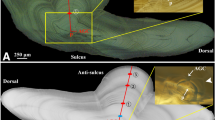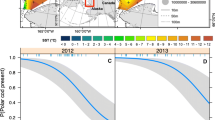Abstract
A high growth rate for Arcto-Norwegian cod, Gadus morhua, in the Barents Sea and adjacent areas from the larva period to the 0-group enhances survival and ultimately recruitment to the fishery. However, it appeared that high growth rates for a cohort through the 0-group were not continued as the cohort ages. Based on survey data, there was a significant negative correlation between the average length at the 0-group and its average length at ages 2 through 8. We provided evidence suggesting that this phenomenon was caused by the inter-annual variability in inflow of warm, prey-rich Atlantic water into the Barents Sea from the Norwegian Sea. Enhanced inflow provided favorable conditions for cod growth during the larva and juvenile pelagic intervals. However, this same strong inflow carried a proportion of the cohort farther to the east in the Barents Sea, where the bottom water is colder than in the west. The colder conditions experienced by such cohorts, as compared to cohorts that have a more westerly settlement, led to slower growth prior to age 2. Slow growth during this interval appeared to be the reason for these cohorts' relatively smaller mean length at older ages.
Similar content being viewed by others
References cited
Ådlandsvik, B. & H. Loeng. 1991. A study of the climatic system in the Barents Sea. Polar Research 10: 45–49.
Aglen, A. & O. Nakken. 1997. Improving time series of abundance indices applying new knowledge. Fish. Res. 30: 17–26.
Anderson, J.T. & R.S. Gregory. 2000. Factors regulating survival of northern cod (NAFO 2J3KL) during their first 3 years of life. ICES J. Mar. Sci. 57: 349–359.
Anonymous 1983. Preliminary report of the international 0-group fish survey in the Barents Sea and adjacent waters in August–September 1980. Ann. Biol. 37: 259–266.
Baranenkova, A.S. 1957. Comparative abundance of year classes of cod and haddock in the Barents Sea according to the quantitative estimation of the young fish and the data on fisheries. Trudy PINRO 10: 54–77 (in Russian).
Bergstad, O.A., T. Jørgensen & O. Dragesund. 1987. Life history and ecology of the gadoid resources of the Barents Sea. Fish. Res. 5: 119–161.
Bogstad, B., T. Haug & S. Mehl. 2000. Who eats whom in the Barents Sea? NAMMCO Sci. Publ. 2: 98–119.
Bogstad, B., G.R. Lilly, S. Mehl, Ó.K. Pálsson & G. Stefánsson. 1994. Cannibalism and year-class strength in Atlantic cod (Gadus morhua L.) in Arcto-boreal ecosystems (Barents Sea, Iceland and eastern Newfoundland). ICES Mar. Sci. Symp. 198: 576–599.
Brander, K.M. 1994. Patterns of distribution, spawning, and growth in North Atlantic cod: the utility of inter-regional comparisons. ICES Mar. Sci. Symp. 198: 406–413.
Campana, S.E. & P.C.F. Hurley. 1989. An age-and temperaturemediated growth model for cod (Gadus morhua) and haddock (Melanogrammus aeglefinus) larvae in the Gulf of Maine. Can. J. Fish. Aquat. Sci. 46: 603–613.
Daan, N., P.M. Bromley, J.R.G. Hislop & N.A. Nielsen. 1990. Ecology of North Sea fishes. Neth. J. Sea Res. 26: 343–386.
Draper, N.R. & H. Smith. 1981. Applied regression analysis, Second edition. Wiley and Sons, New York. 709 pp.
cEllertsen, B., P. Solemdal, T. Strømme, S. Sundby, S. Tilseth, T. Westgård & V. Øiestad. 1981. Spawning period, transport and dispersal of eggs from the spawning area of Arcto-Norwegian cod (Gadus morhua L.). Rapp. P.-v. Reun. Cons. Int. Explor. Mer. 178: 260–267.
Ellertsen, B., P. Fossum, P. Solemdal & S. Sundby. 1989. Relation between temperature and survival of eggs and first-feeding larvae of Northeast Arctic cod (Gadus morhua L.). Rapp. P.-v. Reun. Cons. Int. Explor. Mer. 191: 209–219.
Helle, K. 2000a. Distribution of the copepodite stages of Calanus finmarchicus from Lofoten to the Barents Sea in July 1989. ICES J. Mar. Sci. 57:1636–1644.
Helle, K. 2000b. The influence of biological and physical processes on early juvenile Arcto-Norwegian cod (Gadus morhua L.) with special emphasis on zooplankton abundance. Dr. Sci. Thesis, University of Bergen, Bergen. 113 pp.
Helle, K. & M. Pennington. 1999. The relation of the spatial distribution of early juvenile cod (Gadus morhua L.) in the Barents Sea to zooplankton density and water flux during the period 1978–1984. ICES J. Mar. Sci. 56: 15–27.
Helser, T.E. & F.P. Almeida. 1997. Density-dependent growth and sexual maturity of silver hake in the north-west Atlantic. J. Fish Biol. 51: 607–623.
Jobling, M. 1988. A review of the physiological and nutritional energetics of cod, Gadus morhua L., with particular reference to growth under farmed conditions. Aquaculture 70: 1–19.
Jørgensen, T. 1992. Long-term changes in growth of Northeast Arctic cod (Gadus morhua) and some environmental influences. ICES J. Mar. Sci. 49: 263–277.
Loeng, H., V. Ozhigin & B. Ådlandsvik. 1997. Water fluxes through the Barents Sea. ICES J. Mar. Sci. 54: 310–317.
Marshall, C.T. & K.T. Frank. 1999. Implications of densitydependent juvenile growth for compensatory recruitment regulation of haddock. Can. J. Fish. Aquat. Sci. 56: 356–363.
Maslov, N.A. 1944. The bottom fishes in the Barents Sea and their fisheries. Trudy PINRO 8: 3–186 (in Russian).
Michalsen, K., G. Ottersen & O. Nakken. 1998. Growth of Northeast Arctic cod (Gadus morhua L.) in relation to ambient temperature. ICES J. Mar. Sci. 55: 863–877.
Muchina, N.V., A.I. Muchin & E.A. Dvinina. 1987. Oceanographic conditions and reproduction of Arcto-Norwegian cod of the Barents Sea in 1980–1985. pp. 145–158. In: H. Loeng (ed.) The Effect of Oceanographic Conditions on Distribution and Population Dynamics of Commercial Fish Stocks in the Barents Sea, Proc. 3rd Soviet-Norwegian Symposium, Murmansk, Institute of Marine Research, Bergen.
Nilssen, E.M., T. Pedersen, C.C.E. Hopkins, K. Thyholdt & J.G. Pope. 1994. Recruitment variability and growth of Northeast Arctic cod: influence of physical environment, demography, and predator–prey energetics. ICES Mar. Sci. Symp. 198: 449–470.
Ottersen, G., K. Helle & B. Bogstad. 2002. Do abiotic mechanisms determine interannual variability in length-at-age of juvenile Arcto-Norwegian cod? Can. J. Fish. Aquat. Sci. 59: 57–65.
Ottersen, G. & H. Loeng. 2000. Covariability in early growth and year-class strength of Barents Sea cod, haddock and herring: the environmental link. ICES J. Mar. Sci. 57: 339–348.
Ottersen, G., K. Michalsen & O. Nakken. 1998. Ambient temperature and distribution of north-east Arctic cod. ICES J. Mar. Sci. 55: 67–85.
Ottersen, G. & S. Sundby. 1995. Effects of temperature, wind and spawning stock biomass on recruitment of Arcto-Norwegian cod. Fish. Oceanogr. 4: 278–292.
Ozhigin, V.K. & N.G. Ushakov. 1985. The effect of the thermal conditions of the sea and atmospheric circulation on the distribution of the Barents Sea capelin feeding areas. pp. 149–156. In: H. Gjøsæter (ed.) Proceedings of the Soviet-Norwegian Symposium on the Barents Sea capelin, Bergen, Norway, 14–17 August 1984, Institute of Marine Research, Bergen.
Rollefsen, G. 1953. Observations on the cod and cod fisheries of Lofoten. Rapp. P.-v. Reun. Cons. Int. Explor. Mer 136: 40–47.
Sundby, S. 2000. Recruitment of Atlantic cod stocks in relation to temperature and advection of copepod populations. Sarsia 85: 277–298.
Sundby, S., H. Bjørke, A.V. Soldal & S. Olsen. 1989. Mortality rates during the early life stages and year-class strength of Northeast Arctic cod (Gadus morhua L.). Rapp. P.-v. Reun. Cons. Int. Explor. Mer 191: 351–358.
Sundby, S. & P. Bratland. 1987. Spatial distribution and production of eggs from Northeast-arctic cod at the coast of Northern Norway 1983–1985. Fisken og Havet 1987 (1): 1–58 (in Norwegian).
Author information
Authors and Affiliations
Rights and permissions
About this article
Cite this article
Helle, K., Pennington, M., Bogstad, B. et al. Early Environmental Influences on Growth of Arcto-Norwegian Cod, Gadus Morhua, From The 0-group To Adults. Environmental Biology of Fishes 65, 341–348 (2002). https://doi.org/10.1023/A:1020581415071
Issue Date:
DOI: https://doi.org/10.1023/A:1020581415071




